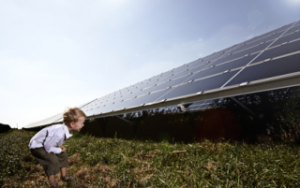Spreading “Energy Democracy”
 In the village of Granville in Central Ohio, a group of environmentally-aware and civic-minded citizens gathered in the spring of 2013. Their purpose was to explore the economic and ecological possibilities of solar power not just for themselves, but for the good of their community. As a result, they created the Licking County Solar Farm Co-op, which is not only a source of solar energy for its members, but a solar learning center as well.
In the village of Granville in Central Ohio, a group of environmentally-aware and civic-minded citizens gathered in the spring of 2013. Their purpose was to explore the economic and ecological possibilities of solar power not just for themselves, but for the good of their community. As a result, they created the Licking County Solar Farm Co-op, which is not only a source of solar energy for its members, but a solar learning center as well.
The co-op partnered with Joe and Larke Recchie of Community Renewable Energy, who agreed to host the co-op at their home. The host site manages and maintains the system, paying back the members on their investment based on the amount of power produced. It also pays the utility for excess energy produced.
Granville is the home of many educational institutions as well as local independent businesses, and the co-op hopes to partner eventually with some of these organizations. The co-op praises the Granville area as a leader in innovation and sustainability, and considers itself to be carrying on this tradition.
The co-op is setting out to educate people in the area about the advantages of community-owned solar, which is, in their words, “inclusive, allowing renters, students, businesses, nonprofits, and owners of shaded properties to support renewable energy, shrink their carbon footprints, and enjoy a return on their investment.” This description accords with what the Center for Social Inclusion (CSI) calls “energy democracy,” in which community members have a say in what kinds of energy they will use or create, and how they will employ it.
